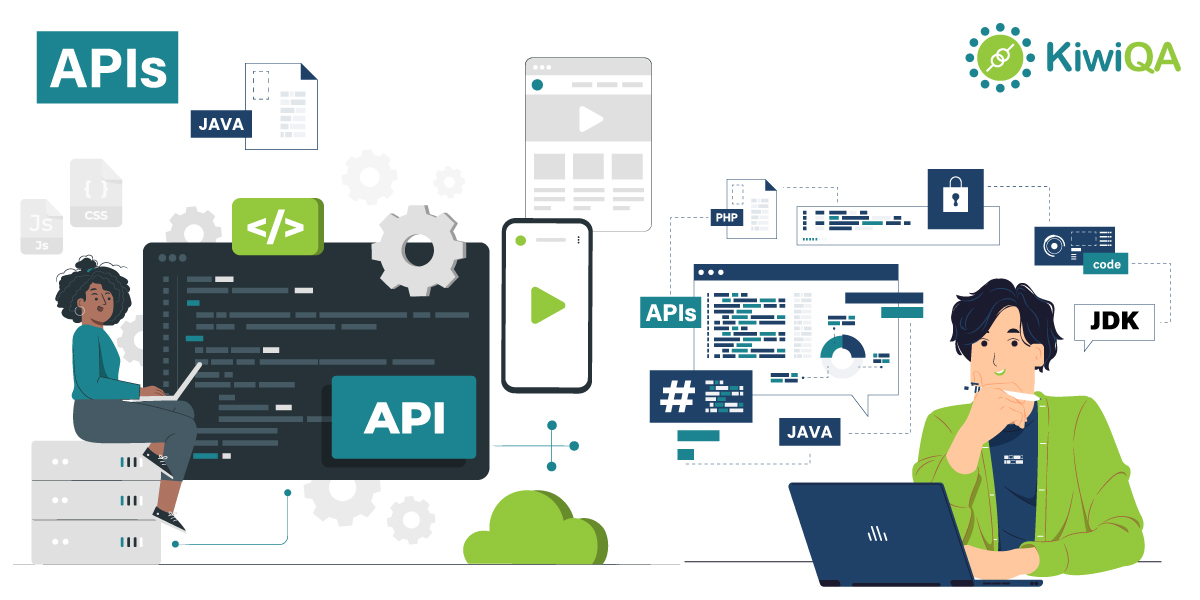API Testing: Challenges and Best Practices

 KiwiQA
KiwiQABe it developer or tester, you would have surely come across the acronym API. It is the short form for Application Programming Interface. Whether an application is built on the principles of monolithic or microservices architecture, it would surely consist of APIs. This is because APIs help the application components interact with each other in a programmatic way.
On similar lines, APIs also aid in interacting with resources outside your own code. For instance, Java JDK (Java Development Kit) consists of APIs which in-turn includes classes, packages, interfaces and their associated methods, constructors, etc. APIs can be broadly classified into public APIs, private APIs, and partner APIs.
As the name suggests, public APIs are APIs that come with no strings attached. These APIs do not come with any restrictions since they can be used by everyone. Private APIs are APIs that can only be used by authorized users. For instance, APIs offered by a cloud provider can only be used if you have a valid account on the platform and have necessary permissions to use the APIs in your application.
Lastly, partner APIs are APIs that are normally used by enterprises once they have some kind of a partnership. These APIs are normally built using the REST (Representational State Transfer) architecture. For instance, cloud analytics companies like Sumo Logic expose a bundle of APIs that lets its integration partners interact with the Sumo Logic platform.
Irrespective of the type of API being developed, it is important to perform thorough API testing whereby you can test the APIs from a performance, security, and reliability standpoint. Imagine the repercussions on business if malicious users make use of the APIs in an unintentional way.
Like any other form of testing, API testing is also marred with challenges. Onboarding an experienced API testing company can prove beneficial in the long-term. In this blog, we deep dive into the major challenges in API testing along with touching base on the best practices that will help you build maintainable, scalable, and highly functional APIs. So, let’s get started….
Before we look into the integral nuances of API testing, let’s revisit some of the basics of this testing methodology. As the name suggests, API testing involves testing the API thoroughly from the lens of usability, reliability, and security.
Along with this, it is also important to verify whether the intended functionalities of APIs are working as per the requirements. Here is one simple example where APIs are used for the login functionality:
Every website (or app) that requires the users to login would use the Google APIs, Facebook APIs, Amazon APIs, Twitter APIs, or other APIs based on the OAuth 2.0 protocol. These APIs are primarily used for authentication and authorization. Apart from this, it also provides end-users the flexibility to choose the amount of information being fetched from their account.
Developers and testers of the login screen (shown above) need to test the login functionality with all the APIs using which the users can login to the application. It goes without saying that the respective API providers (i.e. Google, Facebook, Twitter, Amazon, etc.) would have also performed extensive API testing of the public APIs exposed for usage by the developers.
Now that we have touched upon the essentials of API testing, let’s look at some of the challenges that arise with scalable and reliable API testing!
API testing is no alien to challenges, especially if you intend to run API tests in a continuous integration pipeline. Here are some of the challenges that enterprises might face when doing API testing at a large scale:
The case with APIs is that users are less likely to use APIs at an independent level i.e. APIs are majorly used in conjunction with each other. The APIs would mostly be a combination of POST/GET/DELETE.
Depending on the software product category (e.g. e-commerce, SaaS, etc.) developers would come up with relevant APIs that would let you do CRUD (Create, Replace, Update, Delete) operations. We would not get into the roles/rights associated with the usage of APIs since that is beyond the scope of this blog.
Consider a cloud platform that lets users run automated tests on it. Since the users would require access to the platform for using the APIs, the APIs would be private in nature. Here are some of the APIs that might available for such a platform:
Though the above-mentioned APIs can be used independently, it is more likely that users of that platform will use a bunch of APIs to give shape to their requirements. Hence, testing the entire flow becomes more critical.
Also, the complexity of tests will increase if a large number of APIs are exposed to the users. Prioritizing the APIs that need to be considered for testing can become a big challenge for large-scale API testing!
Also Read: How To Choose Right API Testing Solution For Your Business?
Designing and testing APIs not only requires technical expertise but also involves understanding of the business logic. In order to use the APIs, a location on the API server is exposed via which APIs receive requests and send responses.
The design of APIs depend a lot on the business logic as well as the overall architecture of the product. Consider an e-commerce application that lets its partners update their SKUs (Stock Keeping Units). In such cases, you would require APIs through which partners can perform CRUD operations on their respective store on the website.
However, devising and testing APIs for the above scenario requires deeper know-how of the business logic involved in e-commerce applications. Not all API testers come with a deeper understanding of the domain, owing to which you might face significant challenges in testing the APIs.
As mentioned earlier, APIs are primarily used in conjunction with each other. For instance, you might use the POST API to upload product information on the e-commerce store. Later, you may use the UPDATE API to update the information of the items uploaded to your store.
Though these APIs can be used independently, you would consider using a combination of APIs to ensure that the respective operation has completed successfully. Also, once the API is a part of the workflow, you would want the other stakeholders to be informed about the same. This is where the power of cross-platform integrations comes into the picture.
Popular platforms like Teams, Slack, etc. provide APIs that can be added in the operational workflow. Along with the APIs offered by your product, it becomes important to test them in conjunction with the APIs offered by the integration partners (e.g. Slack, Asana, Jira, etc.).
Testing APIs in silos could leave room for bugs, particularly when APIs are used with each other.
Most APIs return the response (if any) in the JSON format. Merely validating the functionality of the API via the response codes can hamper the quality. Some popular HTTP status (or response) codes in REST APIs are below:
Along with the response code, API testers also need to look into the validating of the data that is returned as a part of the response. HTTP headers, JSON properties, specific parts of the response, etc. are some of the factors that can be looked into for validating the API functionality.
Like any other form of testing, it is important to run API tests in a pipeline. This not only helps in testing the functionalities offered by APIs but also aids in securing the APIs.
In such cases, only automated API testing can come to the rescue. Automated API testing tests the APIs on the basis of correctness, functionality, security, and other integral parameters that are integral from an end-user’s standpoint.
Many API testers do not consider running API tests in a DevOps pipeline – a grave mistake that can prove costly when the APIs are already in use by the intended audience.
An outsourced QA vendor with experience in providing QA test automation services can add a lot of value in overcoming the challenges involved in reliable API testing. Now that we have covered the challenges, let’s look at some of the best practices of API testing.
Also Read: API Testing Of Web Applications
Here are some of the best practices that we have derived based on our experience providing automation testing services to a wide range of clients:
The choice of tool becomes extremely important when you want to test APIs at every stage of the development. Irrespective of the type of API (i.e. public, private, or partner), they need to be tested for functionality, security, reliability, and scalability.
As mentioned earlier, it is also recommended to perform API testing as a part of the DevOps pipeline. All of this can be possible, if the APIs are tested using the ideal tool. There are a number of automated API testing tools:
All these tools let you create multi-step testing scenarios that aid in through testing of the APIs in an automated way. Most of these popular automated testing tools also offer integration with popular CI (Continuous Integration) tools like Jenkins, CircleCI, Travis CI, Azure Pipelines, etc.; due to which you can run automated API tests in a continuous pipeline.
Many API testers completely ignore the API responses when deriving the pass/fail status of the respective API. This could turn out to be a huge nightmare when the APIs are rolled out in production!
Hence, API testers should track/record the API responses at every step of testing. Whenever there is any change in the API implementation and its tests result in a failure, testers have the option to revisit/examine the status from the previous builds/tests.
All of this reduces the time taken to zero down on the issues at a faster pace, eventually cutting down the developer feedback time!
Many API testers make the mistake of testing their API only for positive outcomes (i.e. HTTP 200 OK). This is the ideal scenario where the API request was successfully executed on the server.
As it is said “It is better to be safe, than sorry”! The sorry saga of API could be invocations that end up with results other than HTTP 200 Apart from transmitting valid data, you should look into validating the API by passing incorrect parameters. This helps in testing the APIs for negative outcomes.
Akin to test coverage, comprehensive API testing helps in unearthing issues when APIs are tested for both positive as well as negative results.
As mentioned earlier, APIs are normally used in conjunction with other components and/or APIs. There could be a possibility where a dependent component/API is still under development (or testing). In such cases, you could use mock APIs.
API mocking is an approach similar to stubbing where the actual APIs are simulated for generating requests with custom data and getting realistic responses. The catch is that the API is being mocked since it is still under development.
On similar lines, there could be some dependent components that might need to be mocked in the API testing process. These mocked APIs and/or components can be extremely helpful when running integration tests on the fully-developed APIs. On the whole, any form of mocking (API/component) helps in faster test execution by temporarily cutting down the reliance on third-party APIs.
API-related security incidents[1] can result in data breach, economic loss, and lowered customer confidence. The only way to avoid such a grave situation is by prioritizing security and performance aspects of the API from the very beginning!
At every step, APIs must be checked for security flaws and exploits. The bright side is that the popular API testing tools (e.g. Katalon Studio, JMeter, Karate, Postman, etc.) also let you run API security tests in an automated way. These tools also help in unearthing API exploits & vulnerabilities that could otherwise be used by malicious actors in attacking your service and/or stealing vital information.
Also Read: Introduction to API Security Testing
REST API testing is an integral part that helps in shipping more secure, reliable, and functional APIs to the end-users. To make the most out of testing, it is recommended to have automated API testing a part of the CI pipeline.
Shipping the best-quality API can be possible by leveraging the best API-testing practices along with the best-suited tools. A QA automation testing services company like KiwiQA has extensive experience in API testing, a factor that can go a long way in accelerating the API testing and release timeline!
Subscribe to our newsletter for some hand-picked insights and trends! Join our community and be the first to know about what's exciting in software testing.
Welcome to the testing tales that explore the depths of software quality assurance. Find valuable insights, industry trends, and best practices for professionals and enthusiasts.

Fill out and submit the form below, we will get back to you with a plan.
 CRN:
22318-Q15-001
CRN:
22318-Q15-001 CRN:22318-ISN-001
CRN:22318-ISN-001 CRN:22318-IST-001
CRN:22318-IST-001